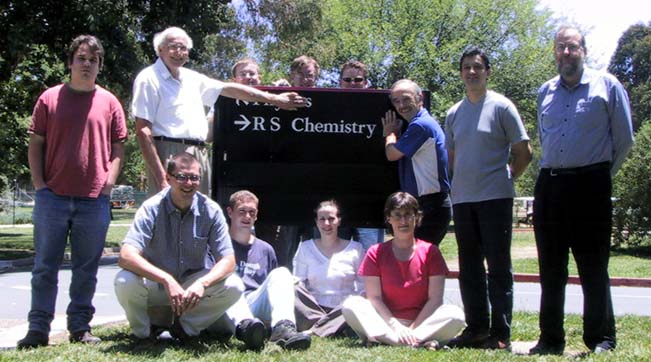Physical and Theoretical Chemistry
Solid State Molecular Science
Professor John White
 Neutron and X-ray scattering methods developed by this
research group are used to study the structure and dynamics on the
nanometre and picosecond space/time scales. Adsorption, self-assembly
at interfaces, polymers, the imitation of biomineralisation phenomena
using “template” molecules and, most recently, the
structure and denaturation of proteins at interfaces are current areas
of interest. The insights gained are used to guide chemical synthesis
in making new materials with interesting physicochemical properties.
One recent highlight has been the first determination of the
thermodynamic parameters for protein denaturation in the 50 Angstroms
surface layer of a protein solution. By comparison with denaturation
in the bulk, the contribution of the surface forces can be measured
quantitatively. Another is the first measurement of the interfacial
structure of an emulsion surface by neutron reflectivity.
“Micro breaking” of the emulsion at the interface with a
solid surface has been detected.
Neutron and X-ray scattering methods developed by this
research group are used to study the structure and dynamics on the
nanometre and picosecond space/time scales. Adsorption, self-assembly
at interfaces, polymers, the imitation of biomineralisation phenomena
using “template” molecules and, most recently, the
structure and denaturation of proteins at interfaces are current areas
of interest. The insights gained are used to guide chemical synthesis
in making new materials with interesting physicochemical properties.
One recent highlight has been the first determination of the
thermodynamic parameters for protein denaturation in the 50 Angstroms
surface layer of a protein solution. By comparison with denaturation
in the bulk, the contribution of the surface forces can be measured
quantitatively. Another is the first measurement of the interfacial
structure of an emulsion surface by neutron reflectivity.
“Micro breaking” of the emulsion at the interface with a
solid surface has been detected.
Our collaboration with Orica Ltd and Food Science (Australia) on
the structure and stability of emulsions has produced scientifically
interesting and practically useful information. We continue to show
that structural relationships at the nanoscale have importance for
rheological and other properties.
The Growth of Highly Ordered Titania- and Zirconia-based Films at the
Air-Water Interface
Growth of highly ordered silicate films at the air-water interface
have led to the development of new metal oxide films based on titania
and zirconia. The surfactant-assisted assembly of these materials at
the air/water interface has been monitored by fast time-resolved X-ray
reflectometry using an instrument in an energy dispersive arrangement,
constructed recently at the Research School of Chemistry. The new
films were robust enough to be characterised by scanning electron
microscopy, energy dispersive spectroscopy and small angle scattering
using X-rays and neutrons.
(with M.J. Henderson, D. King, A. Rennie [NFL, Uppsala Universitet Sweden],
and N. Rosier [Universite Paris-Sud])
The Energy Dispersive X-ray Reflectometer
This instrument is now configured to obtain a Q-range of
0.05 - 0.4 Å–1 with a Q-resolution
approximately 2%. This has been achieved with the use of a liquid
nitrogen cooled Li-Ge diode detector in place of the Bragg rotor.
With X-rays incident onto the sample at ca. 0.6°, this arrangement
permits time-dependent behaviour to minute resolution from either
strong Bragg diffraction from the metal oxide films or from the broad
fringes characteristic of surface excess of protein monolayers at the
air/water interface to be monitored.
(with M.J. Henderson, D. King and A.W. Perriman)
Solvent Effects in High Internal Phase Emulsions
Our previous work using small angle neutron scattering (SANS) and
neutron and X-ray reflectometry on high internal phase emulsions has
shown that these consist of polydisperse micron-scale aqueous
droplets, 90% by volume, suspended in a continuous 10% by volume
hexadecane oil phase. The polyisobutylene based surfactant stabilizes
the droplets within the emulsion by monolayer formation at the
aqueous/oil interface, and by formation of nanometer-scale reverse
micelles within the oil phase. We have begun investigation of
variation in the oil phase by collection of complete sets of SANS data
within the phase space hexadecane-toluene-cyclohexane as a function of
temperature, both from emulsions and microemulsions. Even at this
early stage of analysis strong solvency effects are obvious. Some oil
contents promote emulsion instability or suppress emulsion
formation.
(with K. Baranyai, M.J. Henderson, J. Zank, P.A. Reynolds, and
A. Lafontaine [Universite Paris-Sud])
Ultra Small Angle Scattering from High Internal Phase Emulsions
SANS probes scales from ca. 1 to 50 nm in high internal phase
emulsions, while optical methods probe scales greater than ca. 1000
nm. Structures on scales of 50 to 1000 nanometres are, for technical
reasons, not visible by use of electron microscopy, but are
potentially so by the use of Ultra Small Angle Neutron Scattering
(USANS). Coverage of this gap between SANS and optical microscopy
potentially provides a complete structural description. Apart from
unexpected structures, we already believe that in this gap there are
small aqueous droplets, of unknown minimum size and surfactant
aggregations. We have used the USANS instrument BT-5 at NIST to
provide preliminary data from 20000 nm down to 60 nm on high internal
phase emulsions with various neutron contrasts.
(with M.J. Henderson, J. Zank and P.A. Reynolds, and J. Barker [NIST])

Standing from left to right: Krisztian Baranyai, John White,
Andrew Jackson, David King, Adam Perriman, Gordon Lockhart, Mark
Henderson and Philip Reynolds. Seated from left to right: Hans Zank,
Adrian Hawley, Nikki Johnson and Val Wayte
[
White Group |
RSC Annual Report Index ]
Last revised 18 April 2004 -
Please direct all enquiries to:
Research School of Chemistry
Authorised by the Dean, RSC as relevant officer.
©
2004 The Australian National University
CRICOS Provider Number 00120C

 Neutron and X-ray scattering methods developed by this
research group are used to study the structure and dynamics on the
nanometre and picosecond space/time scales. Adsorption, self-assembly
at interfaces, polymers, the imitation of biomineralisation phenomena
using “template” molecules and, most recently, the
structure and denaturation of proteins at interfaces are current areas
of interest. The insights gained are used to guide chemical synthesis
in making new materials with interesting physicochemical properties.
One recent highlight has been the first determination of the
thermodynamic parameters for protein denaturation in the 50 Angstroms
surface layer of a protein solution. By comparison with denaturation
in the bulk, the contribution of the surface forces can be measured
quantitatively. Another is the first measurement of the interfacial
structure of an emulsion surface by neutron reflectivity.
“Micro breaking” of the emulsion at the interface with a
solid surface has been detected.
Neutron and X-ray scattering methods developed by this
research group are used to study the structure and dynamics on the
nanometre and picosecond space/time scales. Adsorption, self-assembly
at interfaces, polymers, the imitation of biomineralisation phenomena
using “template” molecules and, most recently, the
structure and denaturation of proteins at interfaces are current areas
of interest. The insights gained are used to guide chemical synthesis
in making new materials with interesting physicochemical properties.
One recent highlight has been the first determination of the
thermodynamic parameters for protein denaturation in the 50 Angstroms
surface layer of a protein solution. By comparison with denaturation
in the bulk, the contribution of the surface forces can be measured
quantitatively. Another is the first measurement of the interfacial
structure of an emulsion surface by neutron reflectivity.
“Micro breaking” of the emulsion at the interface with a
solid surface has been detected.